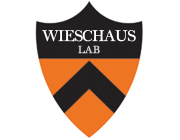The Wieschaus Lab is interested in the patterning that occurs in the early Drosophila embryo. Most of the gene products used by the embryo at these stages are already present in the unfertilized egg and were produced by maternal transcription during oogenesis. A small number of gene products, however, are supplied by transcription in the embryo itself. We have focused on these "zygotically" active genes because we believe the temporal and spatial pattern of their transcription may provide the triggers controlling the normal sequence of embryonic development.
The earliest requirements for zygotic gene activity become apparent at cellularization. The early cleavage divisions in Drosophila involve nuclear mitoses without intervening cytokinesis. Ultimately, they produce a syncytial blastoderm of 6,000 nuclei. "Cellularization" of these nuclei requires a massive, rapid reorganization of the embryonic cytoskeleton that occurs after the 13th cleavage cycle.
This reorganization is blocked by inhibitors of RNA synthesis such as a-amanitin. By screening a collection of chromosomal deletions that span the entire Drosophila genome, we identified those zygotically active loci required at different stages during cellularization. In embryos deficient for three of these genes, the hexagonal arrays of F-actin required to pull plasma membrane down between adjacent nuclei are abnormal, and multiple nuclei are enclosed into single cells. Other loci affect cytoplasmic clearing, membrane synthesis, and the morphology of contractile rings. We have cloned several of these genes and have characterized their role in restructuring the embryonic cytoskeleton. We have also begun analysis of the role of microtubule- based transport in the early embryo, using optical traps and image enhancement to measure forces and kinetic behaviors of individual cellular organelles. Once the embryo has completed cellularization, it begins gastrulation. A ventral furrow and posterior midgut are formed by characteristic changes in cell shape that occur only in the ventral and posterior regions of the embryo. Our analysis has concentrated on genes (folded gastrulation [=fog] and concertina [= cta]) that are required for the process. Using genetic mosaics, we have shown that fog+ expression is required zygotically and only in specific regions of the embryo. Cta expression is required in the maternal germ line, and its RNA is uniform throughout the egg. The surprising homology of the cta gene product to G protein a-subunit argues for cell signaling process coordinating cell shape changes in each invagination.
We are also interested in how complex patterns of cell differentiation are established within epithelial cells at later stage of development. In Drosophila, maintenance of segmental pattern requires interactions between groups of cells that express different "segment polarity" genes. Our work has shown that changes in Armadillo protein levels are among the earliest responses to the intracellular signals that control patterning. Armadillo encodes the Drosophila homologue of §-catinin, a major component of vertebrate adhesive junctions. The proteins that regulate its expression in Drosophila are homologues of vertebrate proteins (Wnt-1, APC) that have been implicated in many forms of human cancer. We are using a variety of molecular and genetic strategies in Drosophila to determine how these genes interact with Armadillo to produce changes in cell morphology and behavior.
Contact
Wieschaus Lab
233N Moffett
Department of Molecular Biology
Princeton University
p 609-258-5383
Lab Manager
Reba Samanta
[email protected]
p 609-258-5401
Faculty Assistant
Galo Guerrero
[email protected]
p 609-258-2933
Lab Website
https://wieschauslab.scholar.princeton.edu/

